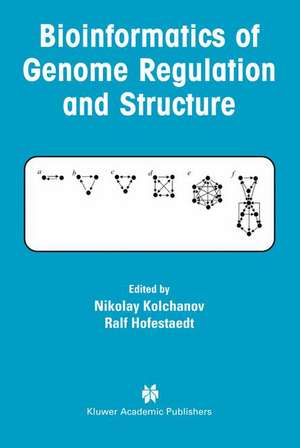Bioinformatics of Genome Regulation and Structure
Editat de Nikolay Kolchanov, Ralf Hofestaedten Limba Engleză Paperback – 25 mar 2013
| Toate formatele și edițiile | Preț | Express |
|---|---|---|
| Paperback (1) | 949.10 lei 6-8 săpt. | |
| Springer Us – 25 mar 2013 | 949.10 lei 6-8 săpt. | |
| Hardback (1) | 956.69 lei 6-8 săpt. | |
| Springer Us – 30 ian 2004 | 956.69 lei 6-8 săpt. |
Preț: 949.10 lei
Preț vechi: 1157.44 lei
-18% Nou
Puncte Express: 1424
Preț estimativ în valută:
181.63€ • 188.93$ • 149.95£
181.63€ • 188.93$ • 149.95£
Carte tipărită la comandă
Livrare economică 14-28 aprilie
Preluare comenzi: 021 569.72.76
Specificații
ISBN-13: 9781475746136
ISBN-10: 147574613X
Pagini: 392
Ilustrații: XVI, 374 p.
Dimensiuni: 155 x 235 x 21 mm
Greutate: 0.55 kg
Ediția:Softcover reprint of the original 1st ed. 2004
Editura: Springer Us
Colecția Springer
Locul publicării:New York, NY, United States
ISBN-10: 147574613X
Pagini: 392
Ilustrații: XVI, 374 p.
Dimensiuni: 155 x 235 x 21 mm
Greutate: 0.55 kg
Ediția:Softcover reprint of the original 1st ed. 2004
Editura: Springer Us
Colecția Springer
Locul publicării:New York, NY, United States
Public țintă
ResearchDescriere
Bioinformatics of Genome Regulation and Structure covers:
-regulatory genomic sequences: databases, knowledge bases, computer analysis, modeling, and recognition;
-large-scale genome analysis and functional annotation;
-gene structure detection and prediction;
-comparative and evolutionary genomics;
-computer analysis of genome polymorphism and evolution; computer analysis and modeling of transcription, splicing, and translation; structural computational biology: structure-function organization of genomic DNA, RNA, and proteins;
-gene networks, signal transduction pathways, and genetically controlled metabolic pathways: principles of organization, operation, and evolution;
-data warehousing, knowledge discovery and data mining; and,
-analysis of basic patterns of genome operation, organization, and evolution.
The data presented may be used while solving a wide range of problems, both basic and applied, in various directions of molecular biology, molecular genetics, biotechnology, pharmacogenetics, pharmacology, and adjacent fields of medicine, veterinary, and agrobiology.
-large-scale genome analysis and functional annotation;
-gene structure detection and prediction;
-comparative and evolutionary genomics;
-computer analysis of genome polymorphism and evolution; computer analysis and modeling of transcription, splicing, and translation; structural computational biology: structure-function organization of genomic DNA, RNA, and proteins;
-gene networks, signal transduction pathways, and genetically controlled metabolic pathways: principles of organization, operation, and evolution;
-data warehousing, knowledge discovery and data mining; and,
-analysis of basic patterns of genome operation, organization, and evolution.
The data presented may be used while solving a wide range of problems, both basic and applied, in various directions of molecular biology, molecular genetics, biotechnology, pharmacogenetics, pharmacology, and adjacent fields of medicine, veterinary, and agrobiology.
Cuprins
1. Computational Genomics.- Nucleosomal DNA Organization: An Integrated Information System.- Using Change in Local DNA Sequence Complexity as a Pointer to the Mechanism of Mutagenesis in Inherited Disease.- Properties of Insertion Regions of Drosophila LTR Retrotransposons.- Compositional Asymmetries and Predicted Origins of Replication of the SaccharomycesCerevisiae Genome.- Revealing and Functional Analysis of tRNA-Like Sequences in Various Genomes.- Type-Specific Features of the Structure of the tRNA Gene Promoters.- Mathematical Tools for Regulatory Signals Extraction.- Argo_Viewer: A Package for Recognition and Analysis of Regulatory Elements in Eukaryotic Genes.- Transcription Regulatory Regions Database (TRRD): Description of Transcription Regulation and the Main Capabilities of the Database.- Sitecon—A Tool for Analysis of DNA Physicochemical and Conformational Properties: E2F/DP Transcription Factor Binding Site Analysis and Recognition.- Local Secondary Structure May Be a Critical Characteristic Influencing Translation of Unicellular Organisms mRNA.- Computer Analysis of miRNA-mRNA Duplexes and Its Application to Predicting Possible Target mRNAS of Arabidopsis.- Correlations between Sequence Features of Yeast Genes Functional Regions and the Level of Expression.- 2. Computational Structural Biology.- Latent Periodicity of Many Domains in Protein Sequences Reflects Their Structure, Function, and Evolution.- Logical Analysis of Data as a Predictor of Protein Secondary Structures.- Structure-Specificity Relationship in Protein—DNA Recognition.- Macromolecular Modeling as a Tool for Expanding Bioinformatics Databases.- Graphic Representation of Equilibrium and Kinetics in Oligopeptides: Time-Dependent Free Energy Disconnectivity Graphs.- Solvent Electrostatic Screening in Protein Simulations.- Pdbsitescan: A Program Searching for Functional Sites in Protein 3D Structures.- A Genetic Algorithm for the Inverse Folding of RNA.- Signal Transduction Pathways Initiated via Cell Surface Receptor CD150: In Silico and in Vitro Analysis.- 3. Computational Evolutionary Biology.- Study of the Specific Contextual Features of Translation Initiation and Termination Sites in Saccharomyces Cerevisiae.- Contribution of Coordinated Substitutions to the Constancy of Physicochemical Properties of ATP-Binding Loop in Protein Kinases.- Sporadic Emergence of Latent Phenotype during Evolution.- Similarity Analysis of Inversion Banding Sequences in Chromosomes of Chironomus Species (Breakpoint Phylogeny).- 4. System Computational Biology.- Integrative Analysis of Gene Networks Using Dynamic Process Pattern Modelling.- Development and Analysis of Models of Genetic and Metabolic Networks and Signal Transduction Pathways in the Genenet System.- Extension of Cell Cycle Gene Network Description Based on Prediction of Potential Binding Sites for E2F Transcription Factor.- Mathematical Simulation of Dynamics of Macrophage Gene Network Activated by Lipopolysaccharides and/or Interferon-g.- Computer Dynamic Modeling of the Gene Network Controlling Intracellular Cholesterol Homeostasis.- An Investigation of the Structural Stability of Drosophila Control Gene Subnetwork in Computer Experiments.- Modeling Plant Development with Gene Regulation Networks Including Signaling and Cell Division.- The Global Operation Modes of Gene Networks Determined by the Structure of Negative Feedbacks.- Statistical Analysis of Microarray Data: Identification and Classification of Yeast Cell Cycle Genes.- References.
















